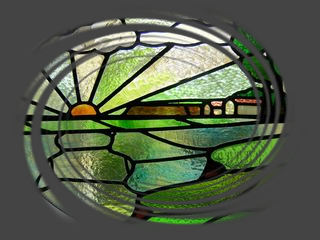
|
Morocco Geology... |

|
Morocco Geology... |
Atlas Mountains
The first stop and first set of views on our geological trip was the Atlas Mountains. These start over in Tunisia and end in central Morocco. The area we traveled through is the High Atlas mountains which are Precambrian basement with Mesozoic and Tertiary rocks overlying them unconformably.
An unconformity means that there is a large time gap where the ancient rocks were uploaded and eroded before they sank below the sea to be covered by the younger rocks. They are then uplifted again so that we see them in the mountains this happened when the land masses of Europe and Africa collided at the southern end of the Iberian peninsula in the Tertiary Era (~65 million to ~1.8 million years ago).
At many of the twists and turns on the roads through the High Atlas Mountains there are opportunities to purchase geological specimens. many are low quality and even more fake, just be careful!
Todra Gorges
Todra Gorge is a massive and spectacular 300m deep with walls of almost vertical bathonian (Jurassic) limestones.
From the floor where you walk you can see a number of geological features such as the dip of the rocks (about 30 degrees south) which can be easily seen in the walls, and some faulting and folding.
The limestones are Bathonian (Jurassic) in age a d whilst we did not have time to study them in detail we did see some limestone features such as stylolites, caves and springs
We did not have time to explore this are in detail, but if you are planning a large geology trip in the are some suggested reading is on the SEPM Sequence Stratigraphy pages
Merzouga
In the area around Merzouga we explores 3 different geological sites
Lead and Zinc Mining
The first site we visited was a mineral site.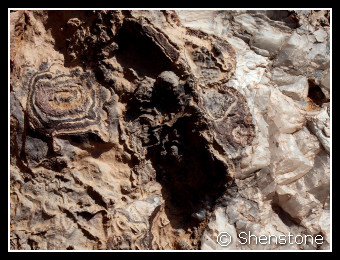
Here the guys who were working the site were descending ( by very poor ropes ) into what looked like a worked out metal mine in a vein. From this they were bringing up the gangue minerals that come with the metal ores and a small amount of the remaining metal ores The minerals we saw at the mine included Galena, Sphalerite, Iron Oxides, Calcite, Quartz, and some copper deposits although it was not clear where these had come from. Where we could see the veins at the surface we could see both massive and stalactitic deposits the latter probably being from hydrothermal rather than cold water deposition
Since coming back I have found a ( detailed geological map online warning VERY large file ) and looking at this there is a clear area of lead workings in the area we traveled around
Orthocone Limestones
The second site we visited was the type of rock we had most wanted to see in our pre-trip considerations it was the famous Orthocone limestones that are worked into so many simply stunning pieces of fossil art and also into many more mundane items such as washbasins and tables.
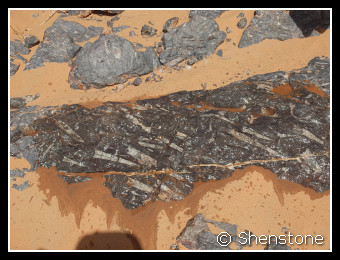 Orthocones are Nautiloids, chambered molluscs a straight ancestor of the coiled ammonites that were so common in later geological periods and the modern Nautilus that we have in seats in the present day. Like these they had a siphuncle which is a tube that ran through the chambers in sequence from the current life chamber where the animal lived to the very 1st chamber it had formed as a juvenile. The Nautiloids and ammonoids all use this siphuncle to regulate the amount of air and water in each chamber to ensure that the whole animal has the correct level of buoyancy for its position in the water column. [An interesting side note is that modern curved Nautilus has been subjected to experiments where the chambers have been flooded and they can be seen to correct their buoyancy over a period of time]
Orthocones are Nautiloids, chambered molluscs a straight ancestor of the coiled ammonites that were so common in later geological periods and the modern Nautilus that we have in seats in the present day. Like these they had a siphuncle which is a tube that ran through the chambers in sequence from the current life chamber where the animal lived to the very 1st chamber it had formed as a juvenile. The Nautiloids and ammonoids all use this siphuncle to regulate the amount of air and water in each chamber to ensure that the whole animal has the correct level of buoyancy for its position in the water column. [An interesting side note is that modern curved Nautilus has been subjected to experiments where the chambers have been flooded and they can be seen to correct their buoyancy over a period of time]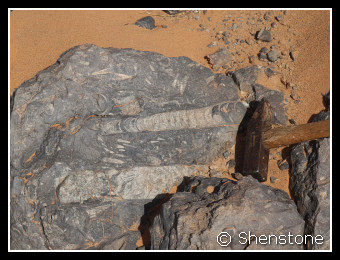
After driving past ridge after ridge we suddenly arrived at one and stopped. Just feet from the car was one of the most fossiliferous sites I have ever seen Orthocones of every size and dimension from a few mm wide to about 10 cm wide and from a few mm long to up to half a meter.
The rock was a Carboniferous aged limestone, dark and hard and in many ways similar to the ones we have in the UK. We were told that it is not worked at this site because it is too fractured for reliable working, and that in fact some of the beds that are worked are beginning to be worked out
With many loose fragments showing siphuncles we had plenty of opportunity to collect useful and interesting samples.
Goniatites galore
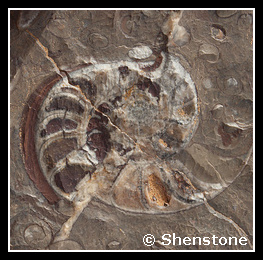 The next location was one where we were promised Ammonites so we had expected mesozoic aged rock, but after a few moments it was easy to see that the septal walls were too simple in structure, being just gentle curves rather than and they were in fact goniatites and the rocks were therefore still in Carboniferous aged rocks.
The next location was one where we were promised Ammonites so we had expected mesozoic aged rock, but after a few moments it was easy to see that the septal walls were too simple in structure, being just gentle curves rather than and they were in fact goniatites and the rocks were therefore still in Carboniferous aged rocks.
The site was much closer to habitation and there were a number of items on offer for sale here , but it was clear that the misidentification of the rocks is deeply ingrained as they were clearly described as "Ammonites" and "Belemnites"
However after looking I did decide I would make my first fossil purchase of the trip because it's part of the fun. A note for this is how some knowledge of what you are looking at can really help when purchasing specimens. We were offered many things of variable quality and when I was bargaining for some items that I had decided were of good quality I was able to get a good price because the vendor was able to see how easily I was identifying the other items that were put in front of me as fakes.
We were getting on well, but the point when I dismissed another vendor who was determined to push his tray in front of me with the wave of a hand and the word "FAKE" caused great amusement and sealed a good price
Taouz
This is the Kem-kem basin, Cretaceous dinosaur country and we had great fun.
The site we were taken to was a cliff of very poorly consolidated sandstones which looked like dune or sandbar deposits, but I admit I haven't read up on the localities yet so that may be wrong.
Rich red sands, steep cross bedding and terrestrial vertebrate fossils all add to the story, however we saw not only the dinosaur teeth, but the teeth of fossil saw fish as well 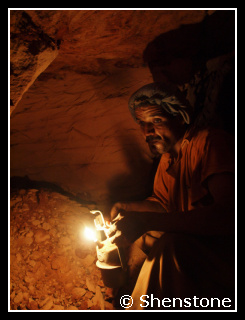
The locality we went to had a number of small entrances into mines along this bed or rock. We stopped at one and there was no one home so we popped in for a quick look, and then rapidly on to another where there was someone working
I was offered an opportunity to look into the mine so as a caver as well as a geologist it was an offer I could not refuse and I followed the miner into the depths. I had thought to take my LED head torch along so the antiquated carbide lamp used by the miner was not the only source of light
Conditions in the mine were awful. temperatures above 40 degrees centigrade and no air movement whatsoever, sand raining down on you every time you brushed the walls or the roof which was only about 1.5 meters at it's highest and more like a meter for most of the time. We went in about 3 meters and I was then shown the working face and his stash of specimens which he carefully unwrapped.
I did manage a few pictures as you can see in the pictures section, but it was impossible to look at the fossils in any detail with the sweat dripping down my face. So we headed back out to the surface where we once again unwrapped things and I was given what was in my opinion the best glass of mint tea of our whole holiday
I selected a raptor tooth from the items on offer and we worked on agreeing a price. I was not unhappy to be given some guidance from Mbarak that the price I should offer should be close to the asking price as he explained this is not a souk and the conditions the miners work in are truly awful. In fact given what he told us as we left (that there were regular deaths in these mines when they have collapses) I think it may have been a bargain.
Since coming back I have identified the tooth as Carcharodontosaurus saharicus and the other more unusually shaped teeth I saw at this mine as the rostral teeth of sawfish Onchopristus numidus there were other long bones available, but out of my price range
Ouzina
Our first site south of the kasbah at Ouzina was a well known and obviously worked trilobite site, but it was for us a bit of a washout (more of a sand-out than wash really) and our guides duly hid in the car whilst we did our fossil hunting. We did find a few almost collectable specimens such as Eric the Half a trilobite (Monty Python reference if you're not sure look up "Eric the Half a Bee") which is a Silurian not really identifiable partial trilobite in an ironstone
We were given a free rein here because there was no active mining in the area and our guide was happy to head back the car and just leave us enjoying ourselves.
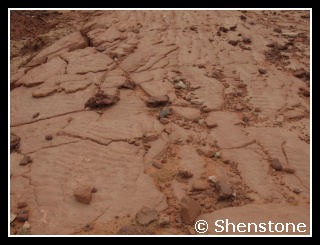 We were taken after that to a site where there were Mesozoic sandstones with plentyful crocodile scutes and other items
We were taken after that to a site where there were Mesozoic sandstones with plentyful crocodile scutes and other items
On the walk back we were pleased to see a section of limestone with some very nice corals
Before heading to our next overnight location we were taken to another local site which I believe to be Devonian in age and was one of the most spectacular fossil reef deposits I think I have ever seen. The number, size and quality of the fossils that we saw there was simply superb and I would have loved to bring more home. However as responsible collectors we limited ourselves to a few small samples of solitary rugose and a piece of colonial coral and some small bryozoan colonies and left the rest for others to see at a future date.
Maerch
I have already commented in the Landscapes section how much I liked the Maerch Oasis as a place to stay and take pictures, but it was a super geological location as well.
Just to the south of the kasbah there was a great fossil hunting locality and it had the added advantage of having some superb structural and sedimentary features to look at as well
Alnif
At Alnif we were guided by Mohammad Bouyiri who was an excellent guide and took us to see a superb Ordovician trilobite site to the south of the town. It was a glorious day, almost too hot for fossil hunting and we struggled to keep up with the pace of exploration of our guide who was incredibly active and accurate with his long handled Estwing rock pick. It was in fact this site that has finally made me decide to get a metal shafted hammer as by this point in our trip our wooden handled hammers were drying out too much and becoming loose, and frankly dangerous to use
Mohammad not only is an excellent guide, but a wonderful preparator and has a fantastic shop where he sells his work. The quality of fossils on sale in this shop would put most major museums to shame. They were simply superb. We decided on just 2 specimens to bring home so purchased a prepared specimen of Reedops sp. Phacops trilobite and a second slab which had Paralejurus sp and Nouveaspis sp. (I can't find this name in literature, but it was the one given to us. I will have to do until I can get a better identification )
Ouarzazate
28 km south east of Ouarzazate we were shown a red rocky bank. This was an exposure of stromatolites. these are 600 million year old Proterozoic Conophyton stromatolite pads, standing almost as they did around 600 years ago.
These are from the Ediacaran Ouarzazate volcano-sedimentary Supergroup in these beds Microbial mats developed along the shorelines of ponds. When depth of water increased the stromatolites developed domal to columnar morphologies that merge (coalesce) laterally to form meter-thick biostromes.
The pictures in this section are taken with my E-30 and E-510 Olympus cameras with the 14-54 and other lenses.